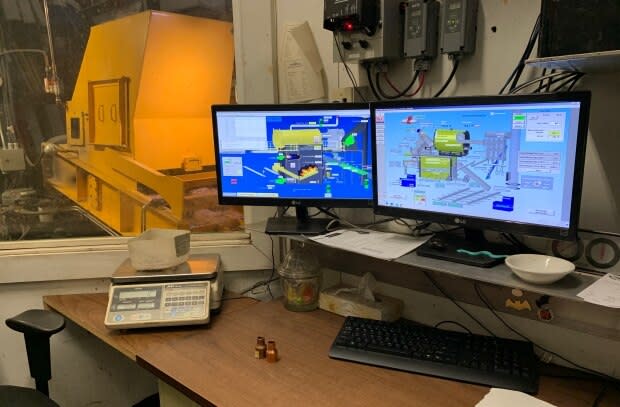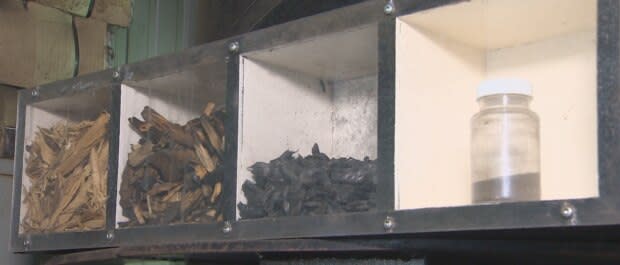Université Sainte-Anne's switch to wood heat shows potential for forest industry
As Nova Scotia's forestry industry tries to adjust to life after Northern Pulp, wood heat projects have been presented as one possible new market for products that right now don't have a destination.
A tender was recently issued for six district heating projects, which would see wood heat systems installed at public buildings and fuelled with low-grade wood from area woodlots.
The Lands and Forestry deputy minister has said 100 public buildings have been identified for potential conversion to wood heat.
The idea is to create a new market for low-grade wood now that Northern Pulp has shut down, which removed the largest buyer of pulpwood and wood chips from Nova Scotia's market.
The possibilities of what that could mean for the industry, however, have been on display at Université Sainte-Anne in Church Point since 2009.
Allister Surette, the university's president and vice-chancellor, said the idea for the conversion to using wood chips to heat the 19 buildings on campus was a product of timing and an interest in reducing the school's carbon footprint.
In a recent interview, Surette recalled hearing a lecture about the town of Güssing, Austria, which had become entirely self-sufficient for its energy needs. He and others from the Municipality of the District of Clare travelled to the town to see its system first-hand.

At the same time, the school needed new oil furnaces, which was the source of heat for the campus at the time.
"While we were looking at replacing the furnaces, we said we should be looking at something that's more environmentally friendly," said Surette.
The result was a $2.5-million project to purchase a custom-made gasification wood chip furnace.
Eventually, a second furnace was added, allowing both to operate when necessary or have one offline for cleaning and maintenance without interrupting service.
The switch had an instant effect for the school. Surette said the annual heating bill dropped from $400,000 to about $200,000.
The heating system also became demonstrably cleaner. A walk through the building that houses the furnaces shows a remarkably clean area that smells like a tree-shaped air freshener.

Chips are fed into an auger by hydraulic rakes and then sent into the furnaces where they're burned until they are reduced to a fine ash-like substance that can be used as fertilizer. A computer system allows for instant monitoring at the site and on technicians' phones so adjustments can be made quickly and as necessary.
A spokesperson for the Lands and Forestry Department said the systems that have gone to tender would be even more efficient than what's in use in Church Point due to advances in technology, creating more heat with the same amount of wood.
Benefit to local economy
The added benefit of the university's system is what it does for the local economy, said Surette. The chips come from Spec Resources, a local provider that buys wood from area landowners.
Spec Resources is an example of reinvention.
Stacks of pulpwood dry out in the company's yard to eventually be chipped. Once chipped, the material is kept in a barn that housed hogs until the province's pork industry took a nosedive
That barn now holds up to 1,000 tonnes of chips at a time, most destined for the university.
"We're trucking in the wood chips from seven kilometres away," said Surette. "It's a local, private entrepreneur that does our wood chips that supplies us on a regular basis and we're saving a lot of money doing it."

That decision also has a trickle-down effect for the 192 members of the Western Woodlot Services Co-op and their 24,000 hectares of woodlots, which are managed by North Range Forest Products.
Harold Alexander of North Range said having that market for wood chips "means everything." About a quarter of his operation's revenue comes as a result of the arrangement with Spec Resources.
"We haven't had a pulpwood market since 2012," he said.
Digby County is a long way from most of the province's major forestry operations. With margins often bark thin, it means transportation costs can easily take away potential markets.

But with the ability to sell low-grade wood to a local business, Alexander and his team can do the kind of management in the woods that is required to grow older, healthier and more valuable forests for their clients. Most of the wood pulled from the forests and sent to Spec Resources travels no farther than 50 km.
"If we didn't have that market, we couldn't do all the thinning," said Alexander.
"One-hundred per cent of the wood that's going from our business to Spec comes from well-managed, local forests."
A few district heating projects won't come close to replacing the 700,000 tonnes of chips Northern Pulp used to buy each year.
In 2019, for example, Université Sainte-Anne used 2,515 tonnes of chips. The six projects in the recently announced tender are to use between 300 and 2,000 tonnes annually.
But Alexander and others believe an aggressive shift to district heating, one that might also include the conversion of hospitals, can create new markets and help diversify an industry that right now needs as many options as it can get.
MORE TOP STORIES


